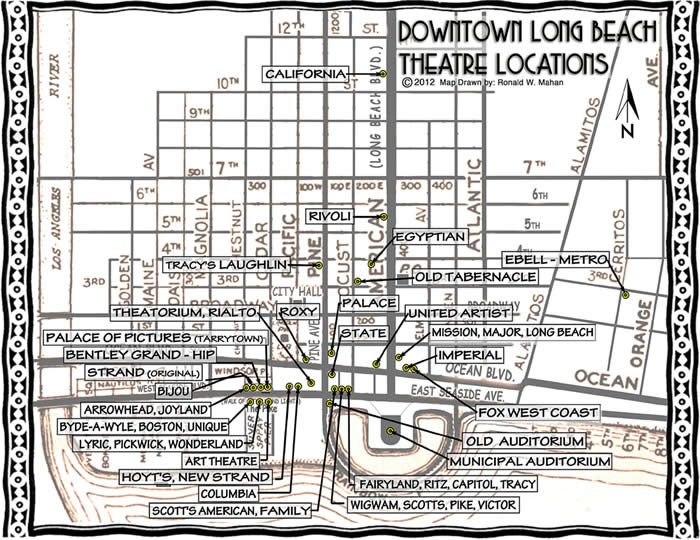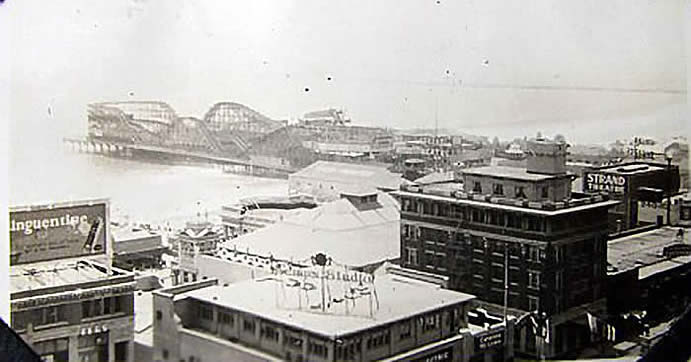Early Long Beach Theatres And Cinemas
Early Long Beach Theatres and Cinemas
Burgeoning “Hollywood,” The Pike, and Theatre by the Sea
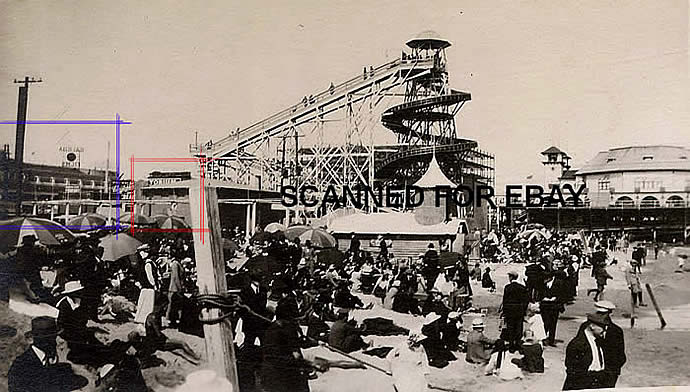
The “Balboa Films” sign is visible (in reverse) atop building at left within the blue square, next to the Theatorium within the red square. At center is the popular Bamboo Slide at the Pike. Courtesy of the Ronald W. Mahan & Joseph J. Musil Photo Theatre Collection
The Coney Island of the West
A different angle with a different studio sign atop the same building as in the photo above. Courtesy of the Ronald W. Mahan & Joseph J. Musil Photo Theatre Collection
The Glory Days of Seaside Theatre
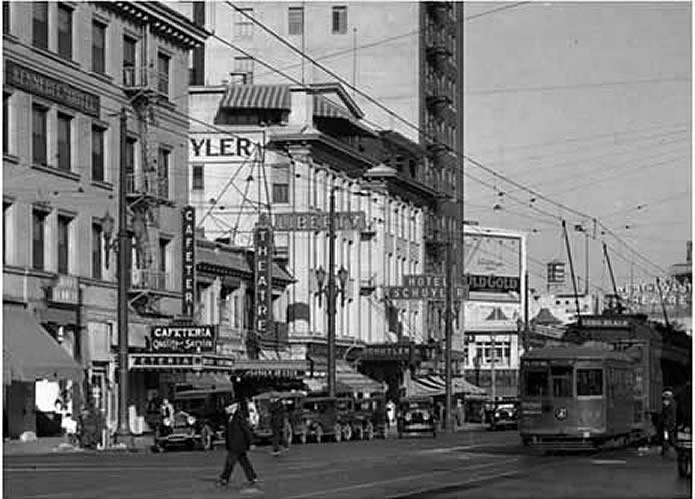
Long Beach as a bustling theatre town: Ocean Boulevard circa 1922, showing the Liberty Theatre, center, and the West Coast Theatre to the extreme right, courtesy of the Ronald W. Mahan & Joseph J. Musil Photo Theatre Collection
This little remembered chapter of Long Beach as a theatre town and rare photos that document its theatres and cinemas were contributed by the Ronald W. Mahan & Joseph J. Musil Photo Theatre Collection, the Historical Society of Long Beach and also Claudine Burnett, former Head of LIterature and History, Long Beach Public Library,
It is the goal of this website page to encourage further research on Long Beach as a world-class theatre town during the first half of the twentieth century, most of the theatres having been situated either at the Pike or within the business district of early Long Beach, coinciding with the heyday of Balboa film productions and certain Balboa premières at these theatres. Unfortunately, none of these palaces exist today. They have all been demolished during the evolution of the city.
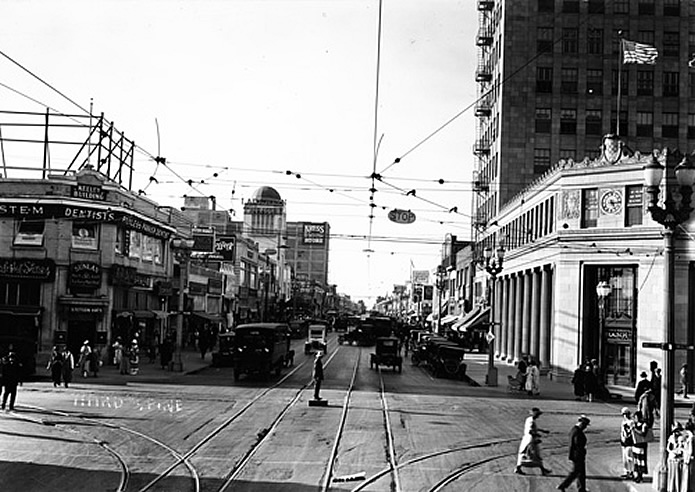
1925 photo looking north up Pine Avenue from Third Street with a view of the domed tower of the Laughlin Theatre to the left, Fourth Street and Pine, Historical Society of Long Beach
Why Long Beach?
Of all possible locations in Southern California for a film plant, one might ask “Why Long Beach?” Actually, this entertainment center was a perfect choice, a seaside resort with many actors and technicians where legitimate theatre and vaudeville prospered before the movie studio was erected in 1910. Theatrical talent was abundant, and many early film actors started out as comedians or vaudevillians. For example, in 1908 Roscoe “Fatty” Arbuckle, who later returned to live and make movies in Long Beach, had been doing summer stock at the Pike, receiving $50 a week as a singer and comedian. That summer Arbuckle performed at the Byde-A-Wyle Theatre, and it was then and there in Long Beach he met, fell in love, and married a young dancer, Minta Durfee. Their romance is captured in Jerry Stahl’s captivating novel entitled, I, Fatty, published by Bloomsbury Publishing in 2004.
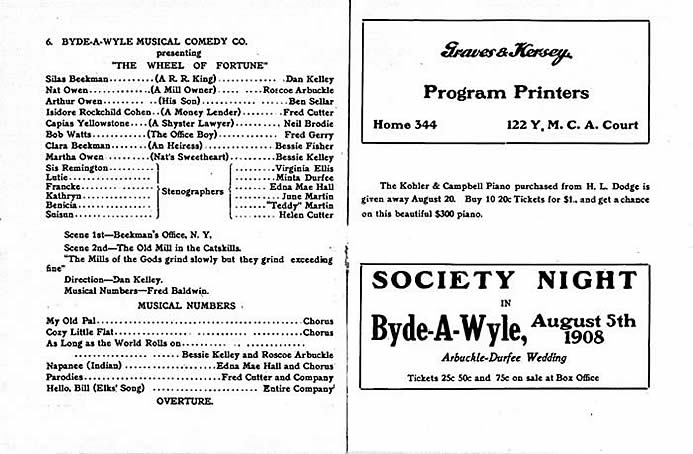
The program above includes Roscoe Arbuckle and Minta Durfee in The Wheel of Fortune, while the box at the bottom right announces on “Society Night,” August 05, 1908, the wedding of Arbuckle and Durfee. The program was provided by the Ronald W. Mahan & Joseph J. Musil Photo Theatre Collection.
Before the California Motion Picture Manufacturing Company was incorporated in 1910, all along the Pike, there were at least eight film houses and two stock company theatres. That summer when Fatty met Minta, they were married on stage by the mayor of Long Beach at the Byde-A-Wyle Theatre, between Chestnut and Cedar, across the street from the elegant Virginia Hotel, the theatre situated below Ocean Boulevard. The Virginia Hotel was located between Chestnut and Magnolia on Ocean Boulevard, having opened its doors that same year, March 25, 1908. Fatty Arbuckle’s marriage took place, August 5, 1908, at the Byde-a-Wyle Theatre with his reception held at the world-class Virginia Hotel.
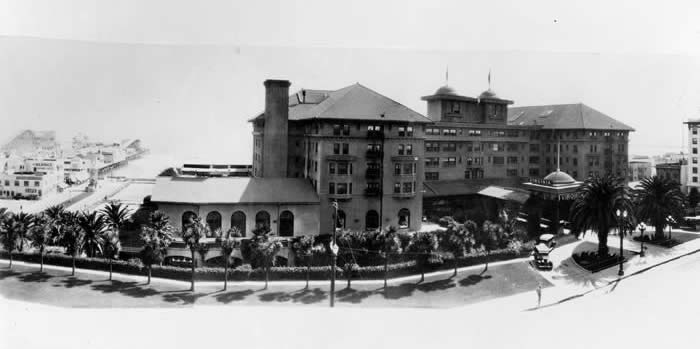
Partial view of the Pike amusement park (left) with the Virginia Hotel (right)
According to Claudine Burnett at the Long Beach Public Library, Long Beach’s enthusiastic involvement with movies began at the turn of the century. In Burnett’s chapter, “Long Beach Motion Picture Industry: 1911-1923,” she explains that the first motion picture was shown, June 22, 1900, in the old Tabernacle, at the northeast corner of Third Street and Locust Avenue. It was an Edison picture with a combat, along with marine scenes. The Tabernacle was also an historical building, erected in the 1880s by the Chautauqua Assembly of Long Beach. In 1900, the Tabernacle was the only assembly hall in Long Beach, a small town then with a population of 2,252 inhabitants.For a small town, the Tabernacle could serve and did serve many functions at the same time—theatre, lecture hall, and church
Following the Tabernacle, in 1907, La Petite Theatre, at 236 Pine Avenue, became the first establishment in Long Beach especially built as a movie house. Burnett states that patrons could see a movie at La Petite for 10 cents, to view Edison’s latest productions: The Bell-Ringer’s Daughter, The Flexible Man, and The Fairy of the Spring. The program was changed Monday, Wednesday and Friday evenings. In addition, Burnett states that the manager of La Petite, Mr. Erwin, attempted to have only the most recent films, yet, despite his efforts to make La Petite a great success, his enterprise failed to make enough profit, and the theatre closed in 1908.
During this early period, Claudine Burnett further recounts that in 1902, the arrival of the Pacific Electric Railway and the building of the amusement zone, called the Pike, not only put Long Beach on the map, but made the city’s population explode. From 1900 to 1910, the population of Long Beach grew a whopping 691%, as the city became a major entertainment center and seaside resort (Balboa Films 17-18).
Early Long Beach Theatres
More early theatres flourished in Long Beach than those listed on the link. In fact, this link also includes four well-known theatres built after the studio ceased production, but in order for this link to coincide with film production at Balboa Studio, this website lists mostly theatres and movie houses built through the end of 1922, with the exception of these four gems from 1924 and 1925: 1) The Brayton Theatre (1925); 2) The Ritz/Capitol/Tracy Theatre (1925); 3) The Egyptian Theatre (1924); The (Fox) West Coast (1925). However, research on these early theatres and cinemas of Long Beach is still ongoing, and for that reason this compilation remains partial and incomplete.
